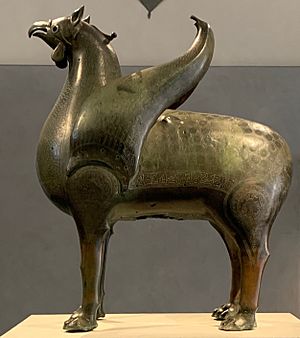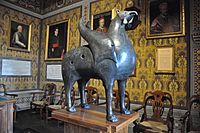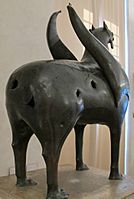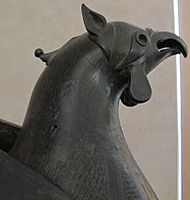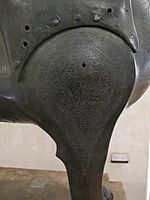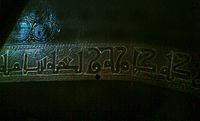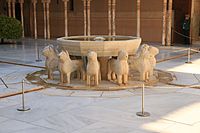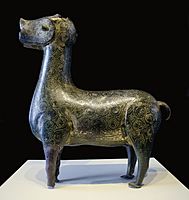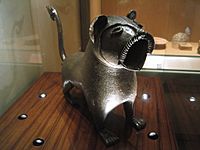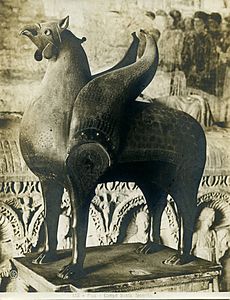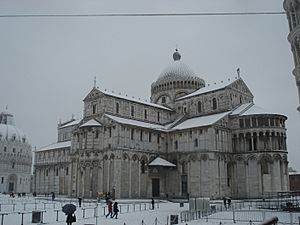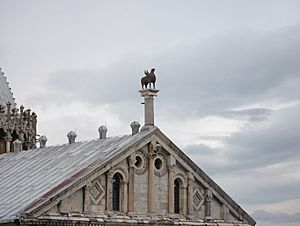Pisa Griffin facts for kids
The Pisa Griffin is a huge bronze sculpture of a griffin. A griffin is a mythical creature with parts of different animals. This amazing statue has been in Pisa, Italy, since the Middle Ages. But it actually came from a place called Al-Andalus (Islamic Spain) and was made around the late 1000s or early 1100s. Today, you can see it in the Museo dell'Opera del Duomo, which is the Cathedral Museum in Pisa.
Scientists used carbon dating to find out when the griffin was made. It was created between 1085 and 1110 AD. The Pisa Griffin is the biggest metal sculpture from the medieval Islamic world that we know of. It stands over three feet tall, which is about 1.07 meters. People say it's the "most famous, beautiful, and important example" of animal-shaped bronze art from that time. For a long time, no one was sure where it came from or what it was used for. Some thought it was a fountain or even a musical instrument!
Contents
What the Griffin Looks Like
The Pisa Griffin is a mix of many animals. It has the head of an eagle and ears like a horse. It also has wattles (fleshy growths) like a rooster. Its body is like a lion, and it has wings. The statue is about 107 cm (42 in) tall, 90 cm (35 in) long, and 46 cm (18 in) wide.
It is made of bronze, which is a type of copper alloy. The wings were made separately and then attached with rivets. The inside of the griffin is mostly hollow. There are cool designs carved into its body. Around its chest and sides, there's an Arabic message written in Kufic letters. It says things like: "Perfect blessing, complete well-being, perfect joy, eternal peace and perfect health, and happiness and good fortune (?) for the owner."
The griffin's wings have designs that look like feathers. Its chest has overlapping, rounded scales. The back has a pattern of plain circles inside two rings. On each leg, there's a special tear-drop shaped area called a cartouche. Inside these areas, arabesque designs surround an animal. The front legs show lions, and the back legs show birds, probably eagles.
There are three openings on the griffin that lead inside. One is at its mouth, another at its back (maybe for a missing tail), and a bigger one under its belly. Inside, there's a bronze "cup" that's open towards the belly.
-
The Pisa Griffin in the Pisa Cathedral's chapter house, 2014.
What Was the Griffin Used For?
As a Fountain
The Pisa Griffin is the largest of many bronze animal statues from the Islamic world. Most of these were smaller. They were used as aquamaniles (containers for pouring water) or incense-burners. A few larger ones were clearly fountainheads. These were probably placed in circles, with water spouting from their mouths. This is similar to the famous stone lions at the Alhambra palace in Granada.
Some historians thought the Pisa Griffin might have been a fountain. Water would have spouted from its mouth. However, this idea has been questioned recently. The griffin doesn't have any parts left from a water system inside it.
-
The Lion Fountain in the Court of the Lions at the Alhambra, built in the 1300s.
-
A 10th-century fountainhead shaped like a deer, from Madinat Al-Zahra, now in Madrid.
-
The Monzón Lion, a fountainhead from the 1100s or 1200s, now in the Louvre museum.
As a Musical Instrument
A newer idea is that the griffin was made to make sounds. It might have been a type of mechanical toy. These toys were popular in Islamic courts. The griffin is hollow inside, except for a small bowl-shaped part at the back. Its hollow body and metal outside could have made it ring like a bell.
The griffin was later placed on top of the Pisa Cathedral. This allowed the wind to blow through it and create different musical sounds. Old writings describe similar large brass lion statues at the Ghumdan Palace in San'a'. These lions would roar like wild beasts when the wind blew through them.
It's thought that the griffin might have worked like a bagpipe. The internal bowl would have held an air bag and kept the air pressure steady. A reed would have been near the griffin's mouth. Wind would enter from the back, go through the air bag and past the reed, then come out the mouth. This would have made musical sounds.
How the Griffin Arrived in Pisa
Most people agree that the griffin arrived in Pisa in the late 1000s or early 1100s. Pisa was a powerful maritime republic (a city-state based on sea trade) at that time. The griffin might have been taken as a prize during one of Pisa's successful "wars" or raids against Islamic states. One possible event was the attack in 1087 on Mahdia in modern Tunisia. Another strong possibility is the Pisan campaign against the Saracens (Muslims) of the Balearic Islands in Spain between 1113 and 1115.
The griffin was placed on a platform high up on the gable (the triangular part of a wall) above the apse (a rounded end of a church) at the east end of the Pisa Cathedral. This was probably when the cathedral was first built, starting in 1064. It was a very important spot, but it was so high up that people couldn't see it closely. Because of this, its Islamic origins were forgotten over hundreds of years. Later local stories said it was a Roman sculpture, something made in Pisa, a war trophy from 1115, or even a magical find when the cathedral's foundations were dug. Since the griffin is made of bronze, people in Pisa might have thought it was similar to old Roman bronze statues. This would remind them of their own city's history.
Later Places the Griffin Has Been
In 1828, the griffin was taken down from the cathedral and moved to the Cathedral Museum. A copy was later put in its original spot. Once people could see it up close, the Kufic writing on it showed its Islamic origins.
In Pisa, the griffin joined other important bronze sculptures displayed in the city's main square. It became part of the famous group of Romanesque architecture in the Piazza dei Miracoli (Square of Miracles). It stands near the Leaning Tower of Pisa and the Baptistry.
In recent years, the griffin has traveled to different art shows. It has been to Berlin, Granada, New York, and Provo (USA).
See also
 In Spanish: Grifo de Pisa para niños
In Spanish: Grifo de Pisa para niños
- Anqa - An Arabian mythical bird of prey.
- Huma bird - An Iranian mythical bird.
- Turul - A Hungarian mythical bird of prey.
- Konrul - A Turkic mythical creature similar to a phoenix.
- Simurgh - An Iranian mythical bird.
- Sphinx - A mythical creature with a human head and lion body from Ancient Greece and Ancient Egypt.


